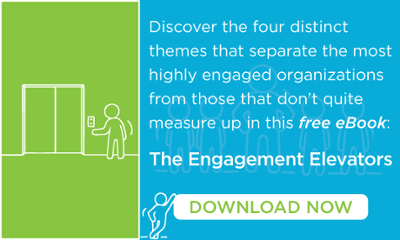
You've heard the term burnout before, and you've probably used it yourself at some point in the past. But what exactly is it?
Burnout is more than just a feeling of stress at work. It's an unshakeable feeling that tends to follow you home from day to day and turn into intense feelings of dread on Sunday night if you know you have to work again on Monday.
It's often a feeling of being unable to muster any enthusiasm or motivation for your work and a lack of pleasure in what you do. And it can feel scary because you may not know how to get yourself out of this place once you're feeling burned out.
It's probably not a surprise that burnout is a big issue for many in the workforce today.
A recent Gallup survey showed that out of the 7,500 employees they studied, 23% of them reported feeling burned out.
That's a significant number and a problem for many reasons. Most obviously, it's not healthy for the employee, and it also hurts the organization.
That same Gallup study also found that of those facing burnout at work, 63% of them are more likely to call in sick, which leads to less overall productivity and increased stress on their coworkers.
But the alternative is not much better.
Those who force themselves to go into the office will likely be 13% less productive!
Burnout Is An Offical Medical Condition
In the past, organizations mischaracterized these employees who were suffering from burnout as either "lazy" or "unmotivated."
But science has now proven otherwise! In 2019, after four decades of debate among experts, the World Health Organization recognized "Burnout" as an official medical diagnosis.
Burnout Syndrom is Characterized By:
1. Feelings of energy depletion or exhaustion.
2. Increased mental distance from one's job or feelings of negativism or cynicism related to one's job.
3. Reduced professional efficacy.
Energy depletion, exhaustion, negative feelings about the job… this explains why research has shown that even engaged employees can experience burnout. It's not that they are unhappy or even disengaged; they are simply depleted and unable to maintain the high standards they expect from themselves.
1 in 5 Highly Engaged Employees Are Suffering From Burnout
Researchers at Yale's Center for Emotional Intelligence found that as many as 1 out of 5 highly engaged employees face burnout.
These individuals tend to have an "always-on" mentality with work which leads to higher levels of stress and exhaustion. On top of that, their companies tend to depend on them to fortify the team, particularly in challenging times.
When these increased demands last for a sustained period without additional support to help offset the increased workload, these engaged individuals will begin to burn out, and many will leave the workplace.
Several factors can cause someone to begin experiencing symptoms of burnout. The most common contributors include:
- A heavy workload and long work hours
- Lack of work-life balance
- Working in a profession that helps/serves others
- Little sense of control over the work
Is Someone You Work With Experiencing Burnout?
So now that you know what can cause it are you curious whether you or someone you work with may be experiencing burnout?
The Mayo Clinic offers a checklist to help us better understand that.
If you can say yes to any of the following, you might be experiencing job burnout.
- Have you become cynical or critical at work?
- Do you drag yourself to work and have trouble getting started?
- Have you become irritable or impatient with coworkers, customers, or clients?
- Do you lack the energy to be consistently productive?
- Do you find it hard to concentrate?
- Do you lack satisfaction from your achievements?
- Do you feel disillusioned about your job?
- Are you using food, drugs, or alcohol to feel better or to simply not feel?
- Have your sleep habits changed?
- Are you troubled by unexplained headaches, stomach or bowel problems, or other physical complaints?
10 Strategies You Can Use To Prevent Burnout
Now that we know what causes burnout and how to recognize it in ourselves and others, let's talk about what to do about it.
If you're a people leader or in any kind of leadership role in your organization, it's important that you work to prevent burnout in those around you.
Here are ten strategies you can use to prevent burnout in those you manage.
1. Provide Clear Expectation
People need to know how to succeed to feel fulfilled at work. That means giving them clear expectations for what success looks like and specific timelines for them to work within. When it's not clear to an employee how they can succeed, it's harder for them to be confident, enjoy their work, and know that they're doing a good job. That uncertainty is directly connected to burnout.
Is there a way for you to clarify the expectations you have for those you manage or the timelines for success?
2. Manage Each Individual As An Individual
The principles of strength-based coaching tell us that when we use our strengths in our work, we can grow by as much as ten times, and we feel energized.
That's where the word "strengths" comes from – when we do those things, they make us feel strong. On the other hand, when we are forced to use our areas of weakness, over time, we feel depleted and "weak." Consider the unique strengths of your employees and think about how you can help them use those innate talents more often. Also, determine whether there is an area of weakness that may be getting in the way of their success.
Is there anything you can take off their plate that would allow them to focus their energy more productively?
3. Give Recognition
It's difficult for people who work hard to feel that their efforts and accomplishments are not recognized. Private acknowledgment, public praise, awards and bonuses, and other demonstrations of appreciation go a long way in keeping morale high and helping people feel energized. When accolades are scarce, burnout is a risk.
Consider who may need a pat on the pack for a job well done today. Giving that pat on the back will immediately make them feel more valued in the organization.
4. Build Strong Two-Way Communication
Strong communication in the workplace is essential. When you create an environment of "Psychological Safety," sharing more with your team and demonstrating trust, your people will be more likely to share their ideas and concerns back with you. In contrast, when employees feel their manager is judgmental or confrontational, they are more likely to keep their problems contained. This leads to feelings of frustration and lack of control, as well as burnout.
Consider how you can improve two-way communication on your team, sharing more important information with them and allowing them to share their thoughts, ideas, and concerns back with you.
5. Schedule Regular One-On-One Meetings
Meeting with your people at regular intervals can improve your relationship and help them be more successful in their jobs. During this one-on-one time, you can discuss their priorities and guide them to avoid spending energy on secondary ones. You can also discuss what they need from you to be successful and get a read for how they're feeling.
Regular meetings like this will make them more comfortable sharing with you and increase the likelihood of spotting signs of burnout. You will be able to step in more quickly and make the necessary adjustments.
If you aren't doing regular one-on-one meetings like this with every employee, this is a great time to start.
6. Provide Short Breaks Throughout The Day
Neuroscience shows that even 60- to 90-second breaks are enough to break the cycle of cumulative stress. Elementary schools often build "brain breaks" into their curriculum to create increased energy and productivity throughout the day. Stanford's Behavior Design Lab advocates using these intermittent micro-breaks for adults in the workplace to prevent burnout.
Is there a way for you to encourage these micro brain breaks during the day? Is it possible to build one into your longer meetings?
7. Establish A Strong Sense Of Purpose
Remember that engagement is the emotional commitment and willingness to give your best at work. If employees are engaged, they feel as though they have a stake in the game and a sense of purpose. This allows them to want to give their best at work. When they know what they are playing for and understand the value of their role, they are willing to put in the effort to achieve success.
Look for ways your engaged team members are contributing to the purpose and mission of your organization –– and acknowledge it when you see it in action.
8. Increase Autonomy
Autonomy allows your employees to have more control over their work and be more flexible. It also increases employee engagement and boosts confidence. Generally speaking, workers who feel restricted and unable to exercise personal control over their environment and daily decisions tend to be at greater risk for burnout.
Take a moment to consider whether you can provide increased autonomy to the people you manage, discussing their work in your one-on-one meetings to provide the necessary support but allowing them to own the day-to-day plan.
9. Ensure Fair Treatment
Unfair treatment like bias, favoritism, mistreatment and unjust policies can hamper relationships in an organization and lead to burnout.
Listen to employee feedback to better understand whether you have issues to contend with, and if you do, tackle them quickly.
10. Encourage Recharging
Many jobs and industries have "crunch times" where workers must work longer hours and handle a more intense workload for a period of time. This can actually help people feel invigorated if the extra effort is recognized, appropriately compensated, and limited. It starts becoming problematic when "crunch time" occurs year-round and there's no time for workers to recover.
Consider ways you can encourage that much-needed recovery time.











Leave a Comment